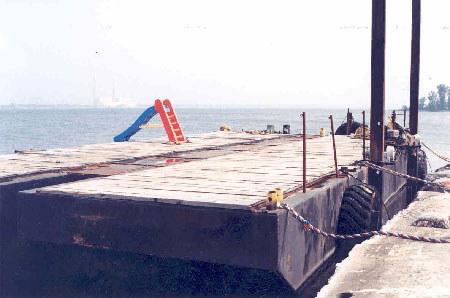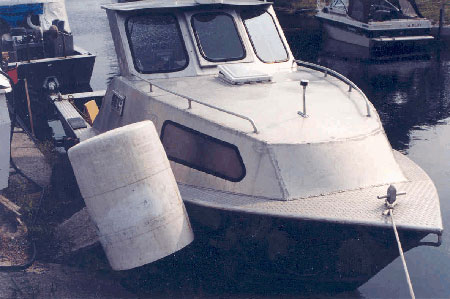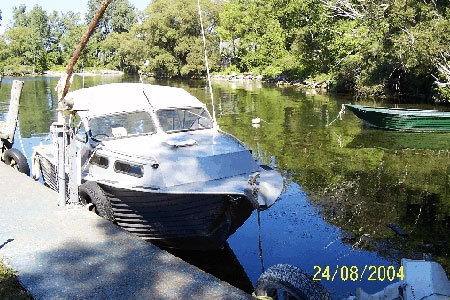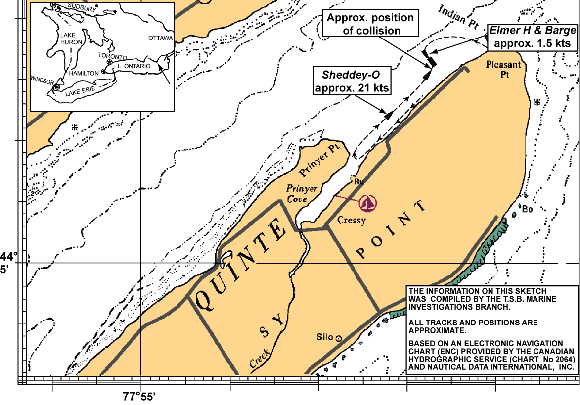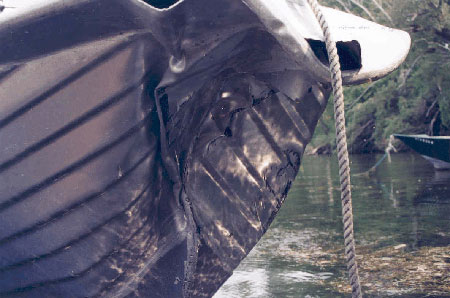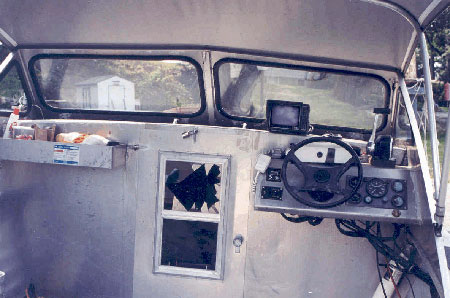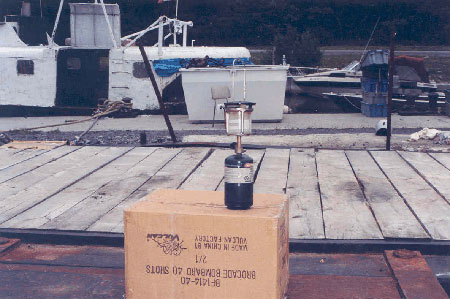Collision
Between the pleasure craft Sheddey-O and the workboat Elmer H and barge
Adolphus Reach, Lake Ontario
The Transportation Safety Board of Canada (TSB) investigated this occurrence for the purpose of advancing transportation safety. It is not the function of the Board to assign fault or determine civil or criminal liability. This report is not created for use in the context of legal, disciplinary or other proceedings. See Ownership and use of content. Masculine pronouns and position titles may be used to signify all genders to comply with the Canadian Transportation Accident Investigation and Safety Board Act (S.C. 1989, c. 3).
Summary
On the evening of 14 August 2004, the pleasure craft Sheddey-O collided with a barge being pushed ahead by the workboat Elmer H. The vessels were proceeding to the staging area for a fireworks display. All five people on board the pleasure craft sustained injuries, with three requiring hospitalization.
Ce rapport est également disponible en français
Factual information
Particulars of the vessels
| Name | Elmer H | Barge | Sheddey-O |
|---|---|---|---|
| Official number, or licence, or CFV number | 368768 | Not registered or licensed | 2E8103 |
| Port of registry | Picton, Ontario | N/A | Picton, Ontario |
| Flag | Canada | N/A | Canada |
| Type | Workboat/Fishing | Spud barge | Pleasure craft |
| Gross tonsFootnote 1 | 2.71 | not measured | 2.00 |
| Length | 7.41 m | 16.76 m | 6.40 m |
| Draught forward | 0.15 m | 0.30 m | Unknown |
| Draught aft | 0.46 m | 0.30 m | Unknown |
| Built | 1980 | 1990 (approx.) | 1986 |
| Propulsion | Gasoline inboard/outboard | N/A | Gasoline inboard/outboard |
| Crew members | 1 | N/A | 1 |
| Others aboard | None | 3 | 4 |
| Owners | Private owner | Private owner | Private owner |
Description of the vessels
Barge
The barge was constructed of two steel floating sections measuring 3.66m by 16.76m joined together by 0.66 m-wide angle irons along the longitudinal centreline. It had a freeboard of 1.52 m. Two spuds were attached to the port side. The barge was used for commercial purposes during daylight hours only, up to the time of the occurrence. There were no fixtures or brackets to which navigation lights could be attached.
Elmer H
The small aluminum workboat was used mostly as a commercial fishing vessel, only occasionally pushing or towing a barge during daylight hours (see Photo 2). The operator's station was located starboard and aft of a small cuddy cabin that was partially enclosed by a hard canopy. The top of this cabin had a flat open area with railings on the perimeter, and a small lower main deck flat that tapered to the bow.
Sheddey-O
The pleasure craft was constructed of aluminum and had an overall design similar to the workboat. The operator's station was located starboard and aft of a small cuddy cabin. A convertible canvas top extended aft from the control station (see Photo 3).
History of the voyage
On 14 August 2004, at approximately 2110 eastern daylight time,Footnote 2 in clear visibility but with approaching darkness, the workboat Elmer H, pushing the barge carrying three people and some fireworks, left the shore near Pleasant Point, Adolphus Reach, in Lake Ontario. The vessel was to be positioned to the southwest, approximately 150 to 200 m from the shoreline, to set off fireworks as part of a private celebration. The workboat was displaying port and starboard running lights and an all-round white light.There were no navigation lights displayed from the barge. The three people on board stood around a propane lamp on the deck; two of them held flashlights that were turned off. No one had been instructed to keep a lookout.
At approximately 2055, a group of five people boarded the Sheddey-O for a short cruise of the area. The group consisted of the pleasure craft operator and four others. They were aware that there was going to be a fireworks display from a barge that evening. The operator and one person were positioned at the starboard control station; the operator was seated at the controls, and the other person stood adjacent. The remaining three people sat on the deck forward of the windshield, obstructing the operator's field of vision. All three wore personal flotation devices.
The Sheddey-O proceeded southwest toward Prinyer Cove at full speed. At Prinyer Cove, the vessel turned and headed northeast to return to the fireworks display area. As darkness was approaching, the operator switched on the vessel's navigation lights - port and starboard sidelights plus an all-round white light. No one was instructed to keep a lookout.
At 2120, the pushtow, which had been proceeding in a southwesterly direction, neared the fireworks staging area and slowed from 5 knots to approximately 1 to 1.5 knots. In anticipation of stopping, a slow course alteration to port commenced.
The operator of the Elmer H then noticed a vessel approaching on a steady course at high speed. As the distance between the two vessels decreased, the operator of the Elmer H noted that the other vessel had not altered course, and he instructed the people standing on the barge to wave their flashlights at the approaching craft. Neither vessel sounded an audible alarm/horn, nor did either attempt to communicate via very high frequency (VHF) radio.
As the Sheddey-O approached the pushtow at a speed of approximately 21 knots, the three people sitting forward of the windshield noticed lights from an object ahead. One person yelled for the operator's attention, but the operator could not understand because of the engine noise. The operator then sought a better view by looking over the shoulder of one of the three persons sitting forward - at which point he saw the barge ahead.
The operator of the Sheddey-O attempted to alter course to starboard at the last moment, but at 2125, the vessel's bow struck the starboard side of the barge at an approximate 90-degree angle, in position 44° 06′ 47″ N latitude, 076° 51′ 12″ W longitude (see Figure 1). The three people on the Sheddey-O's forward deck were thrown forward by the impact; two of them landed on the barge and the third person bounced off the barge and over its port side. This person's personal flotation device then became snagged on the underside of the slow-moving barge, whereupon the operator of the Elmer H stopped the engines and dove into the water to perform a rescue.
Both the operator of the Sheddey-O and the other occupant were tossed about the cabin area.
Injuries
The five people from the Sheddey-O were transported by ambulance to a hospital in Picton, Ontario. The operator suffered crushed ribs. The other occupant of the cabin suffered a broken arm, several broken ribs, and various cuts and bruises after striking the cuddy cabin door and breaking the glass window. Of the three people who had been sitting forward of the windshield, one received serious injuries and two suffered minor injuries.
Damage
The Sheddey-O suffered structural deformation at the bow; this consisted of main deck plate damage, hull deformation, and plate separation from the framing (see Photo 4). The cuddy cabin also suffered minor damage (see Photo 5). Damage to the barge was limited to minor paint scrapes.
Weather
At 2125, as darkness approached, visibility was estimated at between four to five nautical miles for identifying geographical features and lights ashore. The weather, based on the nearest meteorological station at Kingston, Ontario, was overcast with winds from the south-southwest at 9 knots and an air temperature of 19°C.
Navigation lights
The requirements for ensuring the visibility of vessels operating in hours of darkness are prescribed by the Collision Regulations.
Barge
The barge was required to exhibit port and starboard sidelights at or near the forward end, a white light at each end with an arc of 225 degrees, and a special flashing light at the forward end - all of which were to be visible at two miles.Footnote 3
At the time of the collision, these lights were not fitted on board the barge. To light the deck, a propane lamp typically used for camping was placed on top of a 0.3 m-high cardboard box some 2.5 m aft of the bow. Luminosity tests revealed that this light could be seen to a maximum distance of 0.9 to 1.1 nautical miles.Footnote 4
Elmer H
The Collision Regulations required the Elmer H to exhibit two white lights in a vertical line visible at two miles, and sidelights with one-mile visibility.Footnote 5
Workboat operator competency
The operator of the Elmer H had more than 25 years' experience with motorboats and workboats. He held no marine certificate of competency, nor was he required to, and he had no specific knowledge of the requirements for navigation lights for the towing operation.
Proposed requirements for vessel operators as part of the new Marine Personnel Regulations (expected to be in force in 2007) will require a Small Vessel Operator Proficiency or a Pleasure Craft Operator Competency Card.
Pleasure Craft Operator Competency
The operator of the Sheddey-O had 35 years' experience operating a power boat. He did not hold a Pleasure Craft Operator Competency Card, nor was he required to.
The Competency of Operators of Pleasure Craft Regulations are currently being phased in and will require pleasure craft operators to have a Pleasure Craft Operator Competency Card.
Previous occurrences
In August 1999, the TSB conducted an investigationFootnote 6 into a collision between the pleasure craft Sunboy and tug Jose Narvaez, which was towing the barge Texada B.C.. In that occurrence, a temporary sidelight, which did not meet visibility range requirements, was in use on the barge.
Over the past 10 years, the TSB has issued safety communications concerning the substandard display of navigation lights, especially on board working barges.Footnote 7 Of specific concern have been lights that were incorrectly configured, had insufficient range, or were not functioning. Any of these deficiencies can seriously compromise the ability of mariners to see another vessel and hinder their ability to take timely collision-avoidance action.
In response to these communications, Transport Canada (TC) issued Ship Safety Bulletins 03/96 and 09/2000, which warn of the dangers associated with the use of navigation lights that do not comply with the Collision Regulations, particularly with respect to the proper carriage, display, and technical details. They also advise builders, owners, and operators who are unclear as to navigation light requirements to contact a TC Marine Safety office.
Findings
Findings as to causes and contributing factors
- Neither the workboat nor the barge displayed appropriate navigation lights for the towing arrangement, there was no dedicated lookout, and the operator lacked awareness of the appropriate lighting requirements.
- Personnel on the pleasure craft positioned forward of the windshield hampered the operator's forward visibility, and no effective lookout was posted while the vessel proceeded at 21 knots.
- Neither vessel made an attempt to communicate with the other using sound signal or very high frequency radio.
Findings as to risk
- The people sitting on the forward deck of the pleasure craft were at undue risk of falling overboard - be it as the result of a collision (as in this occurrence) or during high-speed turns or sudden stops.
Other findings
- The propane lantern used on the barge had a maximum range of visibility of 0.9 to 1.1 miles.
- The workboat operator had no formal training in navigation and was not certificated, nor was this required by regulations.
This report concludes the Transportation Safety Board's investigation into this occurrence. Consequently, the Board authorized the release of this report on .
